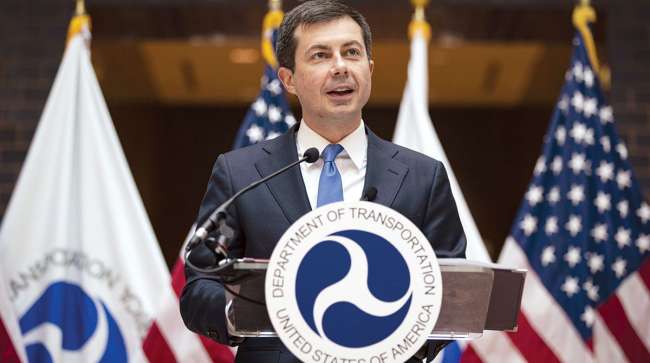Senior Reporter
DOT Announces Strategy to Address Increases in Roadway Deaths

[Stay on top of transportation news: Get TTNews in your inbox.]
The U.S. Department of Transportation on Jan. 27 released a multibillion-dollar plan that calls for actions over the next few years to address what it called “a national crisis in roadway fatalities and serious injuries.”
The “National Roadway Safety Strategy” will focus on five key objectives: safer people, safer roads, safer vehicles, safer speeds and post-crash care.
“This is the first step in working toward an ambitious long-term goal of reaching zero roadway fatalities,” DOT said.
Almost 95% of the nation’s transportation deaths occur on its streets, roads, and highways.
Learn about our brand new comprehensive National Roadway Safety Strategy, a roadmap for addressing our crisis in roadway fatalities and injuries https://t.co/W0maOSEC9E #SaferRoads — TransportationGov (@USDOT) January 27, 2022
“We cannot tolerate the continuing crisis of roadway deaths in America,” Transportation Secretary Pete Buttigieg said in a statement. “These deaths are preventable, and that’s why we’re launching the National Roadway Safety Strategy.”
Buttigieg noted that the program will have funding from the Infrastructure Investment and Jobs Act signed in November by President Joe Biden. The secretary added that every level of government and industry will be involved, “because every driver, passenger and pedestrian should be certain that they’re going to arrive at their destination safely, every time.”
A few of the program’s key elements include:
- Working with states and local road owners to build and maintain safer roadways through efforts including: updates to the Manual on Uniform Traffic Control Devices; a Complete Streets Initiative to provide technical assistance to communities of all sizes; and speed limit setting.
- Leveraging technology to improve the safety of motor vehicles on U.S. roadways, including a rulemaking on automatic emergency braking and pedestrian automatic emergency braking, and updates to the New Car Assessment Program.
- Investment in road safety through funding included in the infrastructure bill, including a new $6 billion Safe Streets and Roads for All program, hundreds of millions for behavioral research and interventions, and $4 billion in additional funding for the Highway Safety Improvement Program.
“We are pleased to see DOT moving forward with a comprehensive national strategy to address highway safety that focuses on all roadway users, given that a high majority of fatal crashes involving trucks are caused by passenger vehicles," said American Trucking Associations' Dan Horvath, vice president of safety policy. "We look forward to the implementation of many safety provisions included in the bipartisan infrastructure bill that pertain to trucking, including working with FMCSA and other stakeholders to further study the causes of truck-involved crashes and determine the best approach to reducing them.”
The plan will build on and harmonize efforts from across the department’s three roadway safety agencies — the Federal Highway Administration, National Highway Traffic Safety Administration and the Federal Motor Carrier Safety Administration, DOT said.
In a letter prefacing the 38-page strategy, Buttigieg said an estimated 38,680 people died in motor vehicle crashes in 2020, and in the first half of 2021, an estimated 20,160 people died, up 18.4% compared to the first six months of 2020.
Nationwide, the rural fatality rate is approximately two times higher than the urban fatality rate, the strategy document said.
The strategy will include $4 billion for improved crash data and vehicle, behavior, and truck safety programs.
DOT said the plan acknowledges both human mistakes and human vulnerability, and designs a “redundant system” to protect everyone.
Want more news? Listen to today's daily briefing above or go here for more info
“People have physical limits for tolerating crash forces before death or serious injury occurs; therefore, it is critical to design and operate a transportation system that is human-centric and accommodates physical human vulnerabilities,” the strategy document said.
“Reducing risks requires that all parts of the transportation system be strengthened, so that if one part fails, the other parts still protect people,” DOT said.
The strategy calls for a “safe system approach” that will aim to design roadway environments to mitigate human mistakes and account for human injury tolerances; expand the availability of vehicle systems and features that help to prevent crashes and minimize the impact of crashes on both occupants and non-occupants; and promote safer speeds in all roadway environments through a combination of thoughtful, context-appropriate roadway design, targeted education and outreach campaigns, and enforcement, DOT said.

Homendy
“The department seeks opportunities to expand the availability and timeliness of data at all levels of government, particularly data on safety impacts to specific user groups and data that advance the knowledge necessary to understand how to significantly reduce serious injuries and fatalities on our highways, roads and streets,” DOT said.
“The U.S. Department of Transportation’s National Roadway Safety Strategy represents the bold paradigm shift we need,” National Transportation Safety Board Chair Jennifer Homendy said in a statement. “Swift action by federal regulators, state and local authorities, and all stakeholders must immediately follow if we are to reverse the deadly public health crisis on our roads.”




